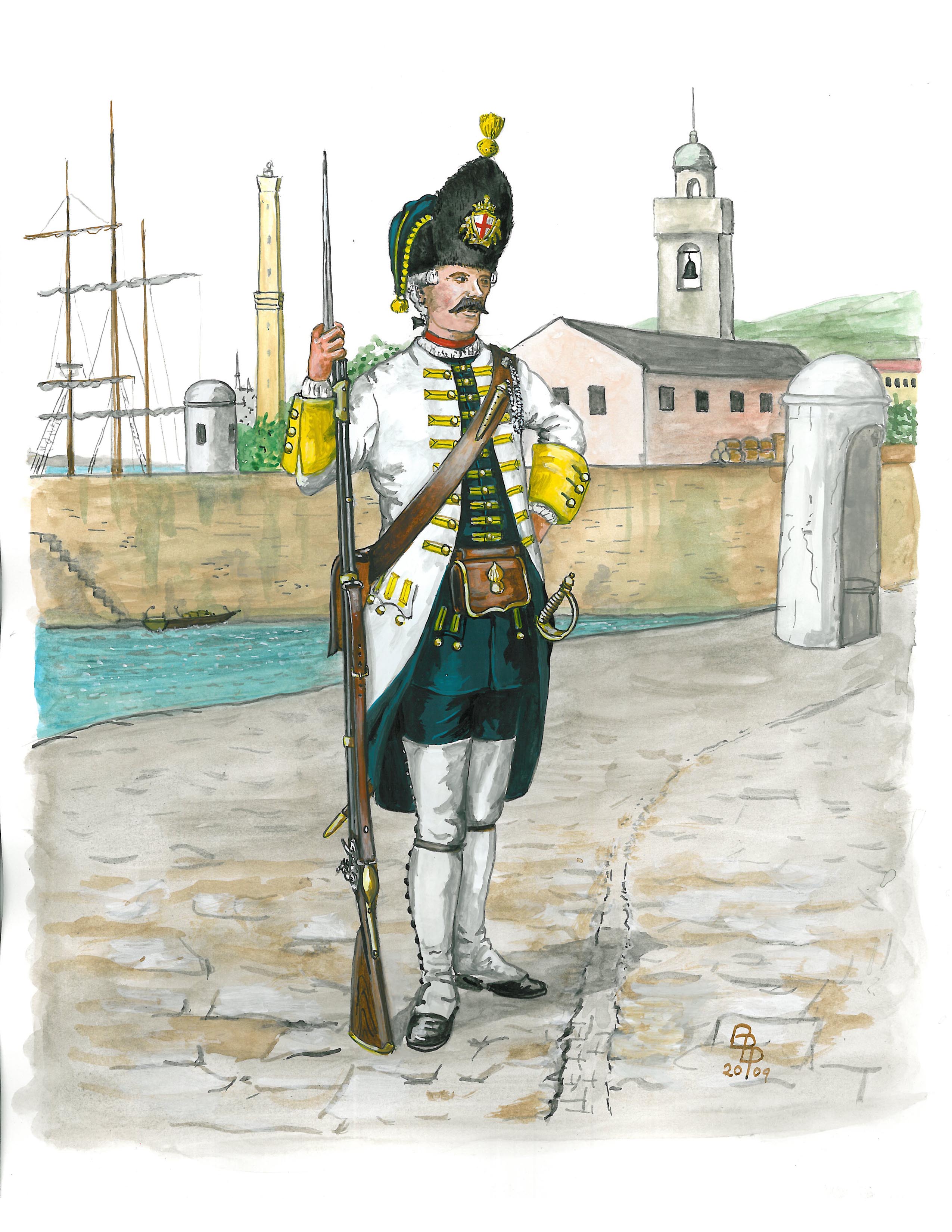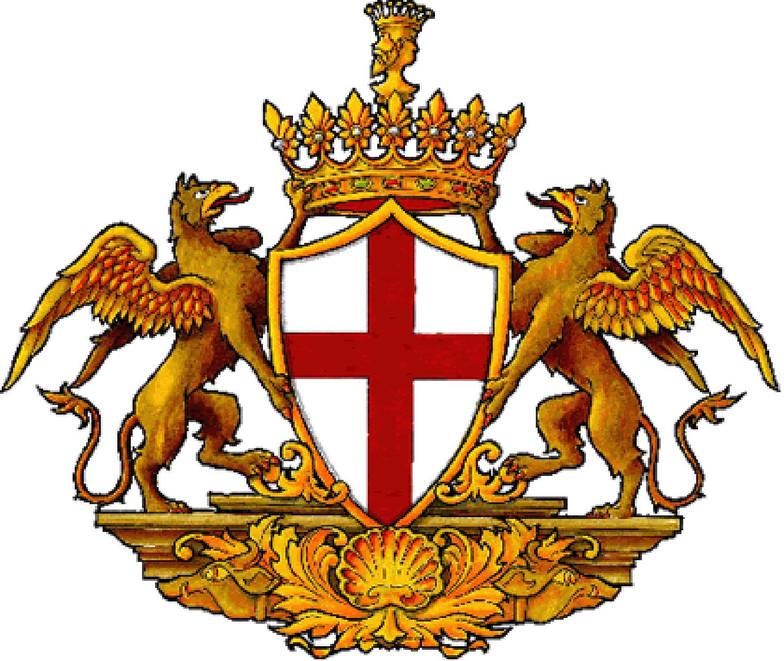Genoa
Grenadier of the Regiment Liguria
1746
The Arms of Genoa
Trade and commerce have existed along the Ligurian coast of Italy since time out of mind. Greeks, Etruscans, Romans, Ostrogoths and Lombards have all used the natural port which became Genoa sometime around the sixth century. By the tenth century settlements in the area were organized enough to defend themselves against Muslim invaders and within 150 years Genoese vessels were trading around the Mediterranean and in the Levant. The Genoese Republic was founded in this period and between the eleventh and twelfth centuries it became a city of over 100,000 people rivaling Venice for commercial supremacy. It was the center for banking and shipbuilding and the source for precious metals, spices, silk, cloth, dyestuffs and medicines from all over the known world. The thirteenth century saw Genoa develop an empire, largely built on diplomacy and trade and settlements grew up in the Levant, Sardinia, Corsica and as far away as the Crimea on the Black Sea.
Genoa and the War of Austrian Succession
The causes and the course of the War of Austrian Succession are Byzantine enough without trying to complicate things more than necessary in this account. During most of the eighteenth century, Genoa had managed to remain neutral, avoiding involvement in the constant dynastic ‘Cabinet wars’ that marked the times. Events in Italy during the War of Polish Succession (1733-1738) ensured that Piedmont-Sardinia and other Italian states would be involved in any ensuing European conflict. The web of alliances and territorial trade-offs that resulted from the Treaty of Worms (1743), enacted after the War of Austrian Succession was well under way, made that a certainty. A clause in the treaty awarded the Marquisate of Finale, a Genoese possession, to Piedmont-Sardinia. The effect was to turn neutral but outraged Genoa into an active ally of her Spanish Bourbon protectors. Genoese money and weapons flowed to the Bourbons and Spanish and French troops were dispatched to the Ligurian coast. However on June 16th 1746 the Gallispan (Franco-Spanish) army was checked at Piacenza and thus began a long retreat, with the Austro-Sardinian army at their heels, through Lombardy, across the Po and over the Appenines into Genoa, which they reached on August 23rd. Their respite was temporary. The Austrians were approaching the Boschetta Pass and a British squadron was preparing to bombard the city. The Bourbons decided to abandon their Genoese allies and press on to Savona and then France. The Austrian occupation of Genoa from early September, was not a gentle one and the staunchly independent Genoese made no bones about their resentment. After little more than two months, a minor incident involving a dispute over the orders of an Austrian officer for civilians to help move a stranded mortar, soon spread and erupted into a city wide revolt. The sheer resolve of the citizens, despite some fractions within its leadership, forced the Austrians to panic and withdraw from the city. By December 10th, the city was liberated and efforts were hastily being made to raise regiments to protect themselves from a return of the oppressors. Soon Genoese troops were fighting alongside their Gallispan allies along the Ligurian coast and the rest of Italy, preventing another concerted effort by Austria to retake the City. Within a year, the force of the war was spent and peace was in the air. By the Treaty of Aix-La-Chappell (October 17th, 1748), the republic of Genoa (along with Modena) were restored, including the original city of contention, Finale. Genoa, however had been devastated by the war; thousands of its citizens had been killed, homes and buildings destroyed and stores and warehouses looted. It would be a generation before it recovered, only to be overtaken by another event; The French Revolution.
The Genoese Army
The Genoese always maintained an efficient army although little had tested their mettle since the age of the crossbowmen. The island of Corsica had been a constant thorn in the side of their colonial masters and troops were dispatched to put down revolts, often brutally, on a regular basis. Virtually all of the formations, for the most part infantry, were established on a company basis raised locally and dressed conventionally with some as grenadiers. There were permanent Swiss companies and recruits were often drawn from Corsica and occasionally cavalry units. In 1737 the army was reformed on a conventional European basis as Battalions. At the time, the army numbered about 7,000 men.
In 1741 grenadier companies were added to the Swiss and Italian mercenary regiments as well as the Corsicans so that each battalion consisted of five companies each. In 1744, with the prospect of war in the offing, the army was increased to 8,000 men as the national regiments received a grenadier company also. Each company consisted of 3 officers, 8 NCOs, 2 drummers and 79 privates. Later, the grenadier companies were broken up and a grenadier NCO and 12 grenadiers were attached to each company. Several more regiments were raised at this time and by 1745 there were 14 battalions including 7 National, 2 Italian, 2 Corsican and 2 Swiss. Most were disbanded by the Austrians when they occupied the city while others fled to the provinces or joined the Gallispan army on its retreat to France.
After the Austrians were ejected 7 of the battalions were re-raised including 5 national, one Italian and one Swiss. However, 11 new battalions were created – 5 national, 1 Italian, 3 Corsican and two other Swiss. Many of these eighteen battalions were disbanded after the war.
Uniforms
The uniforms of the Genoese army were very conventional in terms of style and cut and new regulations were set in 1741. In general, the coats were white for national and Italian regiments, blue for Corsican and red or blue for Swiss. Waistcoat and breeches were blue, the cuffs were of facing color and turnbacks were blue in those regiments with white coats and of facing color in blue and red coated regiments. Hats had white or yellow borders according to button color and grenadier caps were black or brown fur with a high front bearing the arms of Genoa in painted metal. (Cenni shows this badge on every regiment’s grenadier cap although other sources disagree). The bag was of facing color or blue laced in button color with a tassel of the same. Gaiters were above the knee of white linen. Equipment was almost universally natural or polished brown leather. Muskets were mostly French or Spanish in manufacture.
Note: A full list and description of Genoese uniforms will be linked to this article at a later date.
Our illustration, taken from an 1895 Quinto Cenni illustration, shows a grenadier of the Ligurian Regiment, raised in 1746. Although his uniform is mostly in line with others there are some minor differences. It is possible that this unit was formed from somewhat more prosperous artisans in the republic and officered by the merchant class. His coat and waistcoat bear yellow lace bars on the front and pockets. His yellow cuffs have no lace, but curious horizontal buttons and buttonholes. He has a brass grenade and edging on the flap of his waist pouch and his musket may be privately purchased. Behind him is a view from the southwest of the city showing the church of St. Theodore on the right and the famous Lanterna lighthouse on the left.







